1. Ministry of Health and Welfare. Korean Nutrition Society. Dietary Reference Intakes for Koreans 2020. Seoul: Korean Nutrition Society;2020.
2. Institute of Medicine (US) Panel on Dietary Antioxidants and Related Compounds. Dietary Reference Intakes for Vitamin C, Vitamin E, Selenium, and Carotenoids. Washington, D.C.: National Academies Press;2000.
3. Shim JE, Paik HY, Lee SY, Kim YO, Moon HK, Kwon HH, Kim JH. Assessment of vitamin A and E status in Korean rural adult population by dietary intake and serum levels. Korean J Nutr. 2001; 34:213–221.
4. Korea Disease Control and Prevention Agency. Korean Nutrition Society. Development of Database of Vitamin D and Vitamin E for Korea National Health and Nutrition Examination Survey’s Data Processing. Cheongju: Korea Disease Control and Prevention Agency;2021.
5. Wallert M, Börmel L, Lorkowski S. Inflammatory diseases and vitamin E - what do we know and where do we go? Mol Nutr Food Res. 2021; 65:e2000097. PMID:
32692879.
6. Shams MH, Jafari R, Eskandari N, Masjedi M, Kheirandish F, Ganjalikhani Hakemi M, Ghasemi R, Varzi AM, Sohrabi SM, Baharvand PA, et al. Anti-allergic effects of vitamin E in allergic diseases: an updated review. Int Immunopharmacol. 2021; 90:107196. PMID:
33221170.

7. Browne D, McGuinness B, Woodside JV, McKay GJ. Vitamin E and Alzheimer’s disease: what do we know so far? Clin Interv Aging. 2019; 14:1303–1317. PMID:
31409980.
8. Cordero Z, Drogan D, Weikert C, Boeing H. Vitamin E and risk of cardiovascular diseases: a review of epidemiologic and clinical trial studies. Crit Rev Food Sci Nutr. 2010; 50:420–440. PMID:
20373188.

9. Peh HY, Tan WS, Liao W, Wong WS. Vitamin E therapy beyond cancer: tocopherol versus tocotrienol. Pharmacol Ther. 2016; 162:152–169. PMID:
26706242.

10. Ahn S, Jun S, Kim SA, Ha K, Joung H. H. J. Current status and trends in estimated intakes and major food groups of vitamin E among Korean adults: using the 1~6th Korea National Health and Nutrition Examination Survey. J Nutr Health. 2017; 50:483–493.

11. Kim YN, Cho YO. Vitamin E status of 20- to 59-year-old adults living in the Seoul metropolitan area of South Korea. Nutr Res Pract. 2015; 9:192–198. PMID:
25861427.

12. Ahn S, Jun S, Kang M, Shin S, Wie GA, Baik HW, Joung H. Association between intake of antioxidant vitamins and metabolic syndrome risk among Korean adults. J Nutr Health. 2017; 50:313–324.

13. Choe JS, Paik HY. Several variations of nutritional intake and quality in adults in longevity areas. J Korean Soc Food Sci Nutr. 2004; 33:668–678.
14. Korea Disease Control and Prevention Agency. 2016–2018 Guidebook for using the data from Korea National Health and Nutrition Examination Survey. Cheongju: Korea Disease Control and Prevention Agency;2020.
15. National Institute of Agricultural Sciences. Korean Food Composition Table (version 9.1). Wanju: National Institute of Agricultural Sciences;2019.
16. Ministry of Health and Welfare, Korea Centers for Disease Control and Prevention. Guidelines for Nutrition Survey: Korea National Health and Nutrition Examination Survey 6th (2013–2015). Cheongju: Korea Centers for Disease Control and Prevention;2015.
17. National Institute of Agricultural Sciences. Korean Food Composition Table (9.2 version). Wanju: National Institute of Agricultural Sciences;2020.
18. Ministry of Food and Drug Safety. Nutrition Facts of Eating-Out (2019). Cheongju: Ministry of Food and Drug Safety;2019.
19. Ministry of Food and Drug Safety. Nutrition Facts of Eating-Out (2020). Cheongju: Ministry of Food and Drug Safety;2020.
20. Ministry of Food and Drug Safety. Nutrition Facts of Processed Food (2020). Cheongju: Ministry of Food and Drug Safety;2020.
21. Ministry of Food and Drug Safety. Nutrition Facts of Processed Food (2019). Cheongju: Ministry of Food and Drug Safety;2019.
24. Chinese Center for Disease Control and Prevention. China Food Composition Table (6th version). Beijing: Chinese Center for Disease Control and Prevention;2019.
26. National Research Council. Recommended Dietary Allowance. 10th ed. Washington, D.C.: National Research Council;1989.
27. Sauberlich HE. Laboratory Tests for the Assessment of Nutritional Status. 2nd ed. Boca Raton (FL): CRC Press;1999.
28. Ministry of Health, Labour and Welfare. Dietary Reference Intakes for Japanese (2015). Tokyo: Ministry of Health, Labour and Welfare;2015.
29. Jiang Q, Christen S, Shigenaga MK, Ames BN. γ-tocopherol, the major form of vitamin E in the US diet, deserves more attention. Am J Clin Nutr. 2001; 74:714–722. PMID:
11722951.

30. Péter S, Friedel A, Roos FF, Wyss A, Eggersdorfer M, Hoffmann K, Weber P. A systematic review of global alpha-tocopherol status as assessed by nutritional intake levels and blood serum concentrations. Int J Vitam Nutr Res. 2015; 85:261–281. PMID:
27414419.

31. Shin H, Eo H, Lim Y. Similarities and differences between alpha-tocopherol and gamma-tocopherol in amelioration of inflammation, oxidative stress and pre-fibrosis in hyperglycemia induced acute kidney inflammation. Nutr Res Pract. 2016; 10:33–41. PMID:
26865914.

32. Ministry of Health. Nutrient Reference Values for Australia and New Zealand (version 1.2). Canberra: National Health and Medical Research Council;2017.
33. Reider CA, Chung RY, Devarshi PP, Grant RW, Hazels Mitmesser S. Inadequacy of immune health nutrients: intakes in US adults, the 2005–2016 NHANES. Nutrients. 2020; 12:1735.

34. Traber MG. Vitamin E inadequacy in humans: causes and consequences. Adv Nutr. 2014; 5:503–514. PMID:
25469382.

35. Otsuka Y, Iidaka T, Horii C, Muraki S, Oka H, Nakamura K, Izumo T, Rogi T, Shibata H, Tanaka S, et al. Dietary intake of vitamin E and fats associated with sarcopenia in community-dwelling older Japanese people: a cross-sectional study from the fifth survey of the ROAD study. Nutrients. 2021; 13:1730. PMID:
34065253.

36. Kweon S, Park JY, Park M, Kim Y, Yeon SY, Yoon L, Yun S, Park S, Yang JE, Kim Y, et al. Trends in food and nutrient intake over 20 years: findings from the 1998-2018 Korea National Health and Nutrition Examination Survey. Epidemiol Health. 2021; 43:e2021027. PMID:
33872482.

37. Shim JS, Shim SY, Cha HJ, Kim J, Kim HC. Socioeconomic characteristics and trends in the consumption of ultra-processed foods in Korea from 2010 to 2018. Nutrients. 2021; 13:1120. PMID:
33805412.

38. Shim JS, Oh K, Kim HC. Dietary assessment methods in epidemiologic studies. Epidemiol Health. 2014; 36:e2014009. PMID:
25078382.

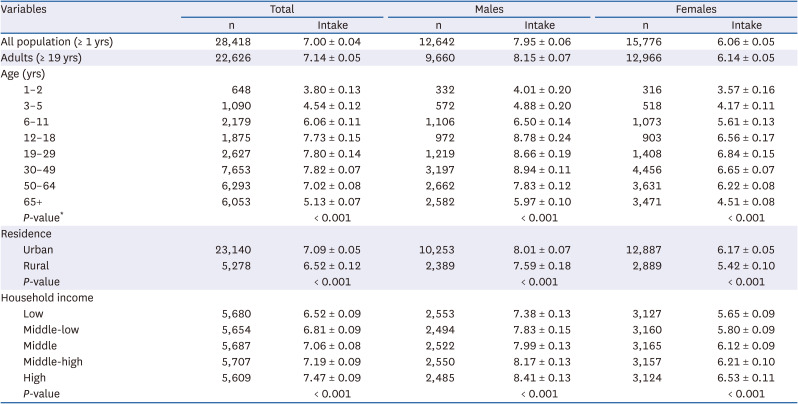
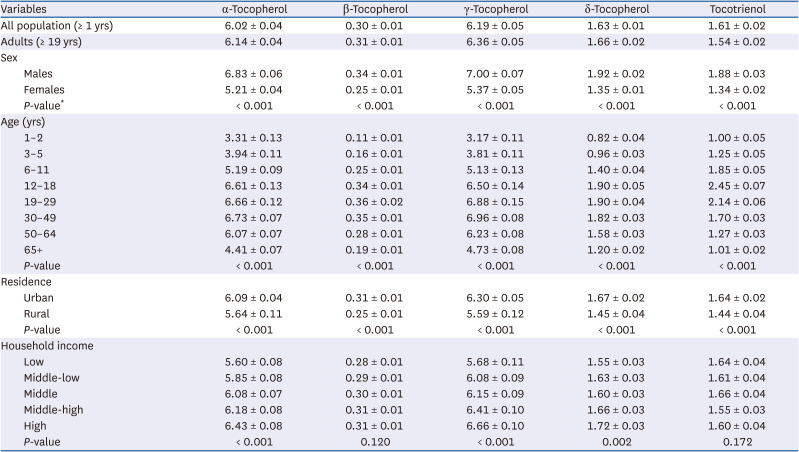
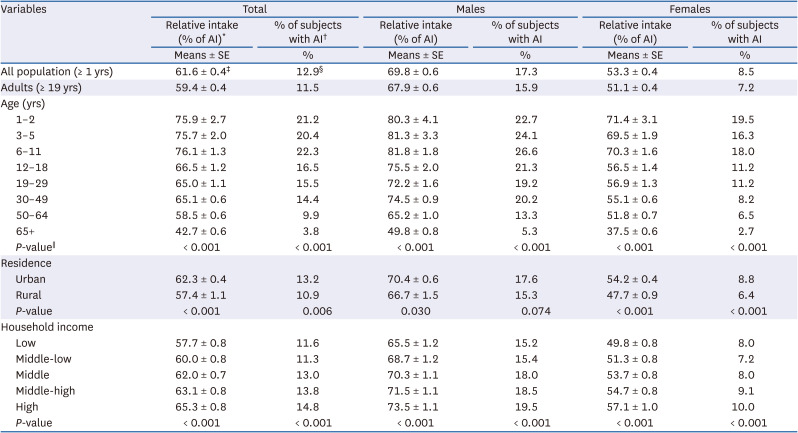
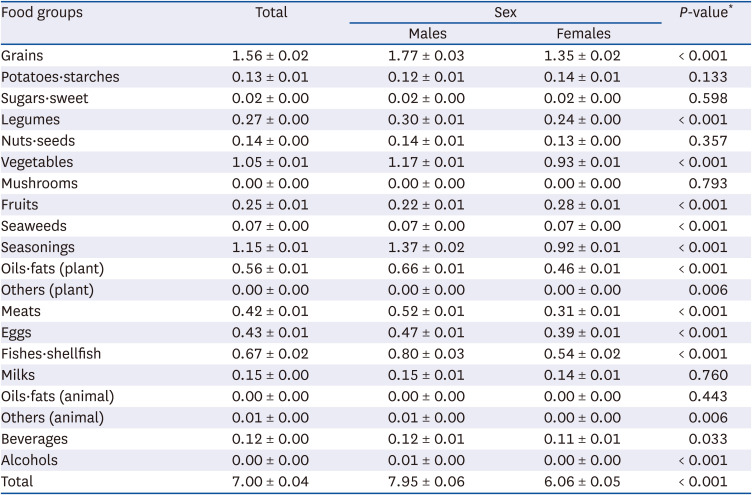
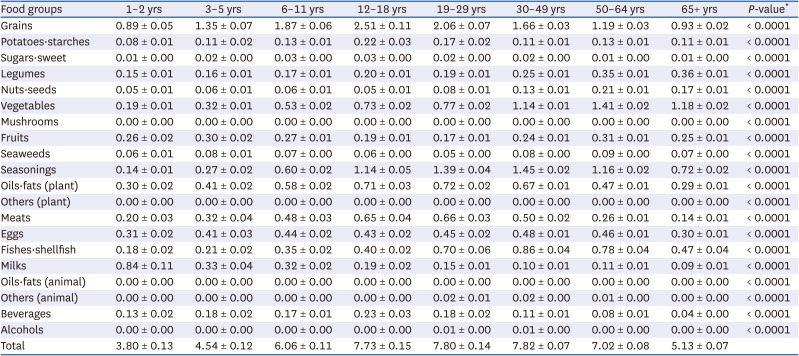
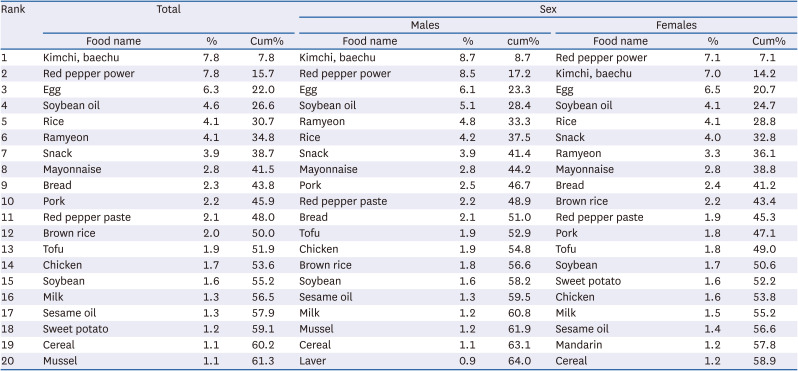
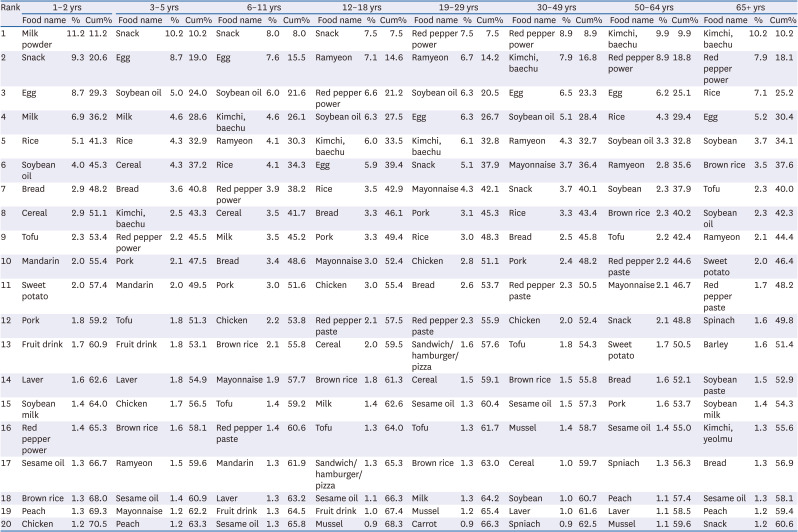




 PDF
PDF Citation
Citation Print
Print




 XML Download
XML Download